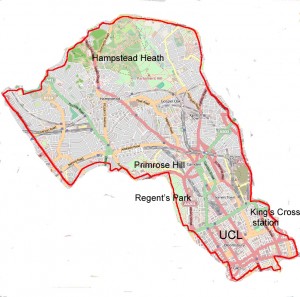Throughout my year abroad in Singapore, I have built knowledge on both the local biodiversity and its management. However, I still consider that I know less than most informed locals (i.e. my classmates), simply because I have been here for a much shorter time.
This led me to question my knowledge of my home’s biodiversity. I am currently studying at University College London (UCL) in the UK, but throughout my (short) life I have only lived 5 years in London (which is still the 2nd longest I have ever spent in one place). Ensued an extremely sobering realisation: to this day, I probably know more about Singapore’s biodiversity than London’s!
As a result, I decided to dig up some information about the area where I live in London: Camden Borough. UCL is located in the Bloomsbury area, between King’s Cross Station and the British Museum, and is included within Camden Borough. Most students live north of the university, within Camden itself. As it turns out, Camden Borough encloses a certain number of urban green spaces, most notably Primrose Hill, parts of Regent’s Park, Regent’s Canal, and Hampstead Heath. The latter covers 320 hectares and includes multiple ponds, three of which are used for open-air swimming throughout the year (water temperature on 20th of March was between 6 to 8°C). There is therefore a lot of potential for wildlife in the borough.
In a recent discussion tutorial within LSM4262, I was quick to point out that English parks are too manicured to have any conservation potential. But what about the smaller parks which are less managed? What about the street trees, the gardens, or any of those pockets of wildlife? In short, what about urban ecology?
Through my research exercise I discovered Camden Borough’s Wildlife and Nature Conservation scheme. Three aims are highlighted: to enhance the natural environment, to promote biodiversity, and to provide opportunities for people to interact with and learn about nature. They offer volunteer opportunities, and encourage people to report wildlife sightings on Greenspace Information for Greater London (GIGL). This organisation has records dating back from 1713 and includes reports from Darwin himself!
The most important feature though turned out to be Camden Biodiversity Action Plan (BAP) which is currently in its third reiteration (running from 2013 to 2018). The BAP focuses on 3 areas: access to nature, the built environment (and its positive contribution to biodiversity), and open spaces and natural habitats. It was developed in collaboration with the local community, different NGOs, volunteer groups, etc. Actions to be implemented are listed with target dates spread out through the years. From their programme description, I noted a few interesting points, all of them highly relevant to urban ecology:
- Camden Borough has areas within the 10% most nature deprived within the country, and 20% least deprived – something to consider when it comes to Human-nature interaction goals.
- Removal of invasive species is an important target with regular active removal in different locations.
- The list of Sites of Importance for Nature Conservation (SINCs) shows that they are managed by as many as 14 different organisations. They range from the Royal Parks, to universities (e.g. UCL, King’s College), and even to Network Rail (authority in charge of UK’s rail network). Bringing in all those different organisations to agree on a plan is an achievement in itself, and this highlights the benefit of having a single authority, such as NParks, managing green spaces across a large area.
- The list of protected species in the borough included many species I had never paid attention to before and would have not expected in an urban environment (e.g. Peregrine falcon, Falco peregrinus)!
Overall, this was a really interesting discovery, as it gave me a better idea of what was going on back home, and also how I could potentially get involved in the future. While reading about Natural Deficit Disorder, many articles mentioned that new generations are only aware of exotic natural environments which are far away from their homes. As an environmental biologist I would like to say that I am more aware of my local environment, but this experience proved me wrong. You are taught a lot at university, but sometimes you also need to go out and make your own research about your own neighbourhood. After all, who would trust a British (well, French in my case) ecologist who can identify a Tembusu tree (Fagraea fragrans) but not a London Plane (Platanus x acerifolia)?
Here is a link to Camden Council page dedicated to the BAP, with a detailed pdf available at the bottom:

Sylvaine, I’ve been to Camden – it was one of my favourite areas in London. I’m curious about where you think Camden fits in along the socio-economic spectrum and how that relates to what you’re describing.
Camden borough, which goes beyond the classic perception of “Camden” itself, is quite unique from a socio-economic perspective. Indeed, it includes Highgate (commonly called “Billionaires row”), multiple universities (UCL, SOAS, Birkbeck), a touristic landmark (Camden market) and numerous council estates (UK’s social housing). This results in an extremely diverse population with great differences in income, education, etc. The percentages of nature deprivation recorded clearly translates this disparity…
The BAP appears to me as a great opportunity to encourage populations from the lower end of the socio-economic spectrum to discover areas often perceived as “for the rich” (Highgate gives out on Hampstead Heath, and some of the roads are even private). What is more, the extensive student community may provide keen volunteers to help run such programmes which would be beneficial for both parties.